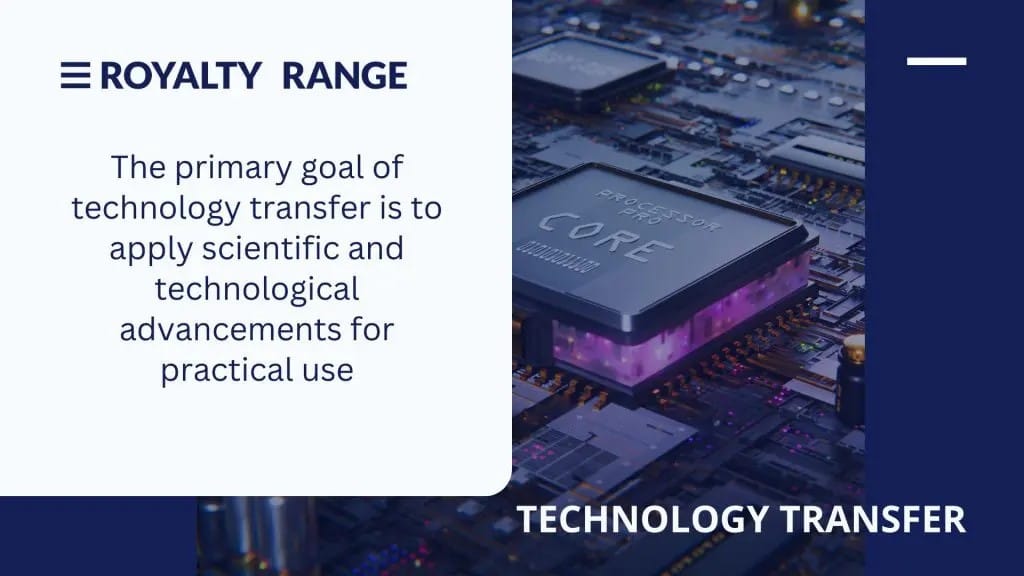Technology transfer
November 15, 2023

In the knowledge economy, intangible assets play a pivotal role, fostering diverse business models and fostering collaboration and technological progress. Safeguarding these assets through Intellectual Property (IP) protection not only fortifies market penetration strategies but also ensures recognition and comprehensive control over competitive advantages.
The triumph of innovations in the market propels innovation and attracts investments for new developments. Facilitating this is the process of technology transfer, enabling the exchange of technology and knowledge, including inventions and scientific discoveries, between organizations or institutions. This transfer fuels the creation of new services and marketable goods.
What is Technology transfer?
Technology transfer refers to the process of sharing or disseminating knowledge, skills, technologies, methods, or intellectual property from one individual, organization, or institution to another. The primary goal of technology transfer is to apply scientific and technological advancements for practical use, fostering innovation, economic development, and improved capabilities.
Key elements of technology transfer include:
- Transfer of Knowledge: Technology transfer involves the exchange of expertise and know-how, often through training programs, collaborative projects, or educational initiatives.
- Intellectual Property Transfer: This aspect involves the licensing or sale of intellectual property rights, such as patents, copyrights, or trademarks, from one entity to another.
- Commercialization of Research: It encompasses the process of turning research findings or innovations into commercially viable products, services, or processes.
- Collaboration and Partnerships: Technology transfer often occurs through partnerships, joint ventures, or collaborations between research institutions, universities, government agencies, and private enterprises.
- Innovation and Adoption: The recipient of technology transfer gains access to new technologies, methodologies, or innovations, which can lead to the development of new products, improved processes, or enhanced services.
- Market Expansion: Technology transfer can facilitate the expansion of markets for specific technologies or products, contributing to economic growth and competitiveness.
Types of agreements
Let’s explore the methodologies, mechanisms, or various types of agreements employed for the transfer of technology and knowledge.
- Direct Assignment or Direct Transfer: Consists of the complete transfer of proprietary technology that implies loss of ownership of the technology.
- License or Franchise Agreement: Encompasses the conveyance of intellectual property rights under predefined conditions, including scope, duration, and geographical limitations, in return for a negotiated royalty, all while retaining ownership.
- Product Sharing Agreement or Joint venture: The development leverages resources and technologies from both the owner and an industrial partner to create a production process, followed by the mutual sharing of the resultant outcomes.
- Turnkey Agreement: When a developer commits to finalizing the technology through an initial investment, ensuring it is fully prepared for use when delivered to the buyer.
- Spin-off company: Establishment of a company through which knowledge, technology, and intellectual property rights are exchanged between the involved parties, facilitating the commercial exploitation of research results by both entities.
- M&A (Mergers and Acquisitions): Like any other asset of the company, technology can be transferred in M&A transactions.
There are two types of methods of technology transfer: vertical and horizontal.
- Vertical Technology Transfer:
- Definition: Vertical technology transfer refers to the exchange of knowledge, technologies, or skills between entities that are at different stages of the production or supply chain.
- Example: When a technology developed by a research institution is transferred to a commercial manufacturing company for the production and distribution of a product.
- Horizontal Technology Transfer:
- Definition: Horizontal technology transfer involves the sharing of knowledge, technologies, or skills between entities that operate at the same or similar stages of the production or supply chain.
- Example: Collaboration between two competing companies in the same industry to share technological advancements or best practices, enhancing the overall industry standards.
In summary, vertical technology transfer moves knowledge across different levels of the production or supply chain, while horizontal technology transfer involves the exchange of knowledge between entities operating at the same or similar levels of the chain. Both forms play crucial roles in fostering innovation, efficiency, and competitiveness in various industries.
Steps of Technology transfer process
The process of technology transfer involves several steps, and the exact sequence can vary depending on the nature of the technology and the parties involved. However, here is a generalized set of steps for technology transfer:
- Identification of Technology: Identify the technology or intellectual property that is suitable for transfer. This could be a new invention, a manufacturing process, software, or any other form of technology.
- Assessment of Suitability: Evaluate the suitability of the technology for transfer. Consider factors such as market demand, potential applications, and the readiness of the technology for commercialization.
- Documentation and Protection: Document the technology thoroughly and, if necessary, protect it through intellectual property mechanisms such as patents, trademarks, or copyrights to safeguard against unauthorized use.
- Market Research: Conduct market research to understand the potential demand for the technology. Identify potential users or licensees who may benefit from the transfer.
- Negotiation and Agreement: Negotiate the terms of the technology transfer agreement. This includes defining the scope of the transfer, licensing fees, royalties, and any other relevant terms.
- Legal and Contractual Formalities: Draft and finalize legal agreements detailing the terms and conditions of the technology transfer. Ensure that all parties involved are legally protected and aware of their rights and obligations.
- Technology Valuation: Determine the value of the technology being transferred. This may involve assessing the economic value, potential return on investment, and other financial considerations.
- Due Diligence: Conduct due diligence to verify the authenticity and viability of the technology. This may include a technical assessment, financial analysis, and legal review.
- Training and Support: Provide training and support to the receiving party, especially if the technology transfer involves a complex process or specialized knowledge. Ensure that the recipient has the necessary skills to utilize the technology effectively.
- Implementation: Implement the technology in the receiving organization. This may involve integrating the technology into existing processes, systems, or products.
- Monitoring and Quality Control: Establish mechanisms to monitor the performance and quality of the transferred technology. Address any issues or challenges that may arise during the implementation phase.
- Feedback and Continuous Improvement: Collect feedback from the technology recipient and use it to make continuous improvements to the technology or the transfer process.
- Commercialization: If the goal is commercialization, develop strategies for marketing, sales, and distribution to maximize the impact of the transferred technology in the market.
- Post-Transfer Relationship: Maintain an ongoing relationship between the parties involved to address any post-transfer issues, provide updates on the technology, and explore future collaboration opportunities.
These steps are intended to provide a general framework for the technology transfer process. The actual process may involve iterations and adjustments based on the specific context and requirements of the technology and the involved parties.
All this information shows the complexity of the process and it is obvious, that some tools or services, that may simplify the process are more than welcome. RoyaltyRange Royalty Rates database will help you in a stage of negotiation and agreement. The database offers high-quality, fully analyzed, clean, and structured data, detailed summaries of the agreement terms and comparability factors, and detailed functional risk, cost, and asset analyses. Agreements are manually analyzed for more than 50 comparability factors. Learn more about the database here. You may also have a live demo or free trial here.
The information provided below is for general informational purposes only and should not be construed as legal or tax advice. It is not a substitute for consulting with a qualified legal or tax professional.
Sources:
https://www.clarkemodet.com/en/articles/how-is-technology-transferred/
https://ic2.utexas.edu/pubs/knowledge-and-technology-transfer-levels-and-key-factors/
https://www.doi.gov/techtransfer/tech-transfer-agreements
https://knowledge4policy.ec.europa.eu/technology-transfer/what-technology-transfer_en
Request One Search
We will perform the search and deliver the initial results within hours, at no cost.




